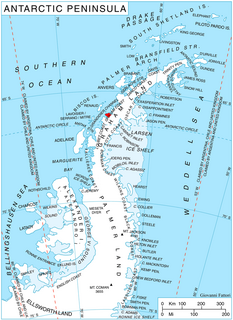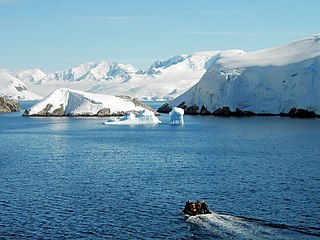Princess Anne Glacier is a glacier in the Queen Elizabeth Range, flowing from the area south of Mount Bonaparte between Cotton and Bartrum Plateaus into Marsh Glacier. Named by the northern party of the New Zealand Geological Survey Antarctic Expedition (NZGSAE) (1961–62) for Anne, Princess Royal, daughter of Elizabeth II of the United Kingdom.
Woodbury Glacier is a glacier just west of Montgolfier Glacier, flowing into Piccard Cove, Wilhelmina Bay, on the west coast of Graham Land. Mapped by the Falkland Islands Dependencies Survey (FIDS) from air photos taken by Hunting Aerosurveys Ltd. in 1956-57. Named by the United Kingdom Antarctic Place-Names Committee (UK-APC) in 1960 for Walter B. Woodbury (1834–1885), English pioneer of photomechanical printing in 1865 and of serial film cameras for use in balloons and kites in 1877.
Bills Point is a headland marking the south extremity of Delta Island in the Melchior Islands, Palmer Archipelago. The name was probably given by DI personnel who roughly charted Delta Island in 1927. The feature was surveyed by Argentine expeditions in 1942, 1943 and 1948.

Bombardier Glacier is a glacier draining southeast from the edge of Detroit Plateau on Nordenskjöld Coast in Graham Land, Antarctica and through a deep trough between Darzalas Peak and Trave Peak to join Edgeworth Glacier and flow into Mundraga Bay. It was mapped from surveys by the Falkland Islands Dependencies Survey (1960–1961), and named by the UK Antarctic Place-Names Committee for Joseph-Armand Bombardier, the Canadian engineer who developed the snowmobile from 1926 to 1937, one of the earliest successful self-propelled over-snow vehicles.
Café Point is a headland lying 2 nautical miles (4 km) south of Zapato Point and 2 nautical miles east of Nansen Island on the west coast of Graham Land. It was charted by the Belgian Antarctic Expedition under Gerlache 1897–99. The name appears on an Argentine government chart of 1954.
Normanna Reef is a reef lying near the center of the south entrance to The Sound in the Melchior Islands, Palmer Archipelago. The name appears on a chart based upon a 1927 survey by DI personnel, but this may reflect an earlier naming by whalers. The name presumably derives from the Normanna Whaling Co. of Sandefjord, Norway, or one of its ships that worked in this area.
Cape Juncal is a prominent cape forming the northwestern extremity of D'Urville Island, in the Joinville Island group, Antarctica. The name appears on an Argentine government chart of 1957 and was applied in remembrance of the Argentine naval victory of 1827 at the Battle of Juncal.
Kusunoki Point is a point on the west coast and near the north end of Renaud Island, in the Biscoe Islands, Antarctica. It was mapped from air photos by Hunting Aerosurveys Ltd, 1956–57, and was named by the UK Antarctic Place-Names Committee for Kou Kusunoki, a Japanese sea ice specialist at Hokkaido University, and from 1966 with the National Institute of Polar Research, Tokyo.
Penfold Point is a point which forms the northwest side of the entrance to Whalers Bay, Deception Island, in the South Shetland Islands. Named for Lieutenant Commander D.N. Penfold, Royal Navy, who conducted a survey of the island during 1948-49.
Eddy Point is a small point located on the south side of Fildes Peninsula, 0.5 nautical miles (1 km) west of Halfthree Point on King George Island, in the South Shetland Islands. It was charted and named by Discovery Investigations personnel on the Discovery II in 1935. The feature is used as a reference point for locating the rocks which lie along the route of boats passing through Fildes Strait.

Ferin Head is a headland 4 nautical miles (7 km) north of the entrance to Holtedahl Bay, in the northwest of Velingrad Peninsula on the Graham Coast of Graham Land, Antarctica. It was discovered by the French Antarctic Expedition, 1908–10, who from a distant position in Pendleton Strait charted this feature as an island, which Jean-Baptiste Charcot named for A. Ferin, French Vice-consul at Ponta Delgada in the Azores. The British Graham Land Expedition (BGLE) under John Rymill, 1934–37, charted this coast and correlated their work with that of Charcot. Ferin Head, as here applied, is in accord with the BGLE interpretation.

Morelli Glacier is a glacier in the western part of King Peninsula, Antarctica, 18 nautical miles (33 km) southeast of Cape Waite, draining northeast to Abbot Ice Shelf in Peacock Sound. It was mapped by the United States Geological Survey from surveys and U.S. Navy air photos, 1960–66, and was named by the Advisory Committee on Antarctic Names for Panfilo S. Morelli, a glaciologist at Byrd Station in 1961–62.
Mount Metcalfe is a mountain at the south side of the head of McMorrin Glacier, 1.5 nautical miles (3 km) south of Mount Wilcox, in Graham Land, Antarctica. It was named by the UK Antarctic Place-Names Committee for Robert J. Metcalfe, a British Antarctic Survey surveyor at Stonington Island, 1960–62, who surveyed the area in 1962.
The Harpun Rocks are submerged rocks lying 0.1 nautical miles (0.2 km) southeast of Bills Point, Delta Island, in the Melchior Islands of the Palmer Archipelago, Antarctica. The name appears on a chart based upon a 1927 survey by Discovery Investigations personnel, but may reflect an earlier naming by whalers. Harpun is a Norwegian form of the word harpoon.
Lobel Island is an island nearly 1 nautical mile (1.9 km) long, laying 2 nautical miles (4 km) southwest of Brown Island in the Wauwermans Islands of the Wilhelm Archipelago, Antarctica. It was charted by the Third French Antarctic Expedition under Jean-Baptiste Charcot, 1903–05, and named for Loicq de Lobel.
Melchior Harbor is a small harbor in the Melchior Islands, Palmer Archipelago, Antarctica, formed by the semi-circular arrangement of Delta, Alpha, Beta, Kappa and Gamma Islands. The name, derived from the name of the island group, was probably given by Discovery Investigations personnel who roughly surveyed the harbor in 1927. The harbor was later surveyed by Argentine expeditions in 1942, 1943 and 1948.
Sayce Glacier is a glacier flowing into Flandres Bay immediately north of Pelletan Point, on the west coast of Graham Land. Charted by the Belgian Antarctic Expedition under Gerlache, 1897-99. Named by the United Kingdom Antarctic Place-Names Committee (UK-APC) in 1960 for B.J. Sayce (1839–1895), English photographer who, with W.B. Bolton, invented the collodion emulsion process of dry plate photography, which displaced wet collodion in 1864.
Spallanzani Point is a point forming the north side of the entrance to Hill Bay and the east tip of Brabant Island, in the Palmer Archipelago. Probably first seen by the Belgian Antarctic Expedition, 1897–99, under Gerlache. Mapped in 1959 from photos taken by Hunting Aerosurveys Ltd. in 1956-57. Named by the United Kingdom Antarctic Place-Names Committee (UK-APC) for Lazaro Spallanzani (1729–1799), Italian physiologist who first interpreted the process of digestion in 1780.
Cape Freeman is a cape marking the east end of the peninsula separating Seligman Inlet and Trail Inlet, on the east coast of Graham Land, Antarctica. The cape was photographed from the air in 1940 by the U.S. Antarctic Service. It was charted in 1947 by the Falklands Islands Dependencies Survey (FIDS), who named it for R.L. Freeman, a FIDS surveyor at the Stonington Island base.
South East Point is a point 1.9 km (1.2 mi) east-north-east of Fildes Point, marking the south-eastern point of Deception Island, in the South Shetland Islands of Antarctica. It was charted by a British expedition 1828-31, under Henry Foster. The name was proposed in 1949 by the Hydrographic Department of the Admiralty, following a survey of the island by Lieutenant Commander D.N. Penfold, Royal Navy, in 1948-49.







